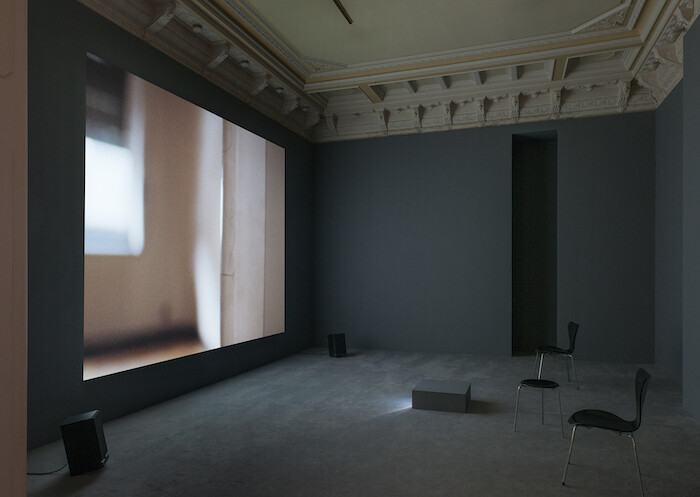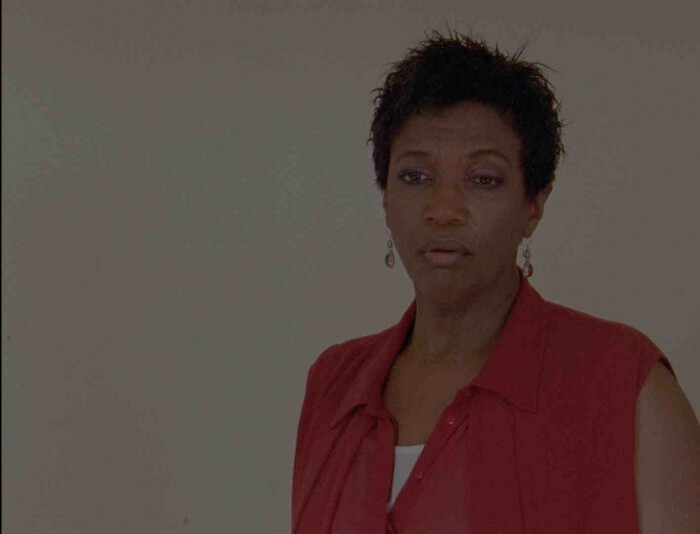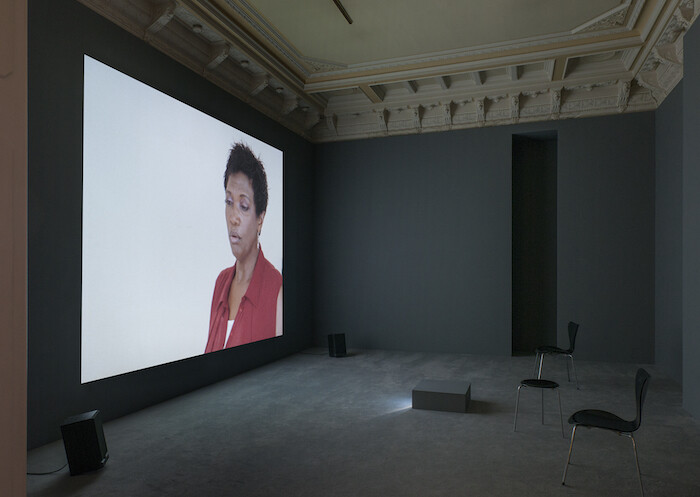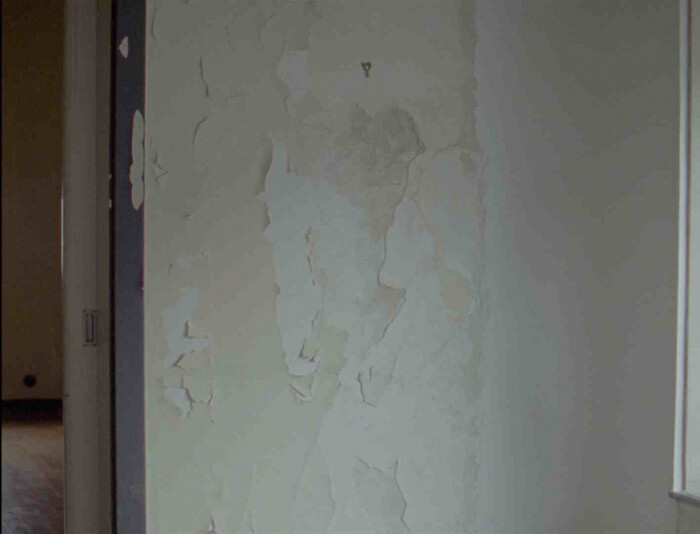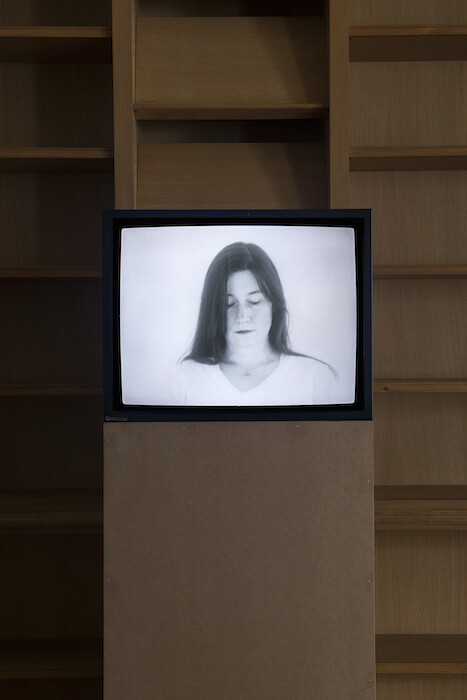Manon de Boer’s minimalist cinema is at its most radical in her latest film On a Warm Day in July (2015), currently on view at Jan Mot, Brussels. Like a number of her films made over the past ten years, it features a performance—American Soprano Claron McFadden improvises on a seventeenth-century song in the empty ground floor of a Brussels townhouse. In previous works by de Boer, such as one, two, many (2012), Dissonant (2010), or Presto, Perfect Sound (2006), the performer is at the center of the film’s concept, and at the center of the camera’s attention, but in On a Warm Day in July the camera quickly abandons the singer and goes on to wander and explore her surroundings. Void of objects, the space is filled with history, each crack on the wall or scrap of detaching wallpaper a mesmerizing cinematic presence.
In de Boer’s work there is often an evacuation of the visual image, giving way to the prominence of the soundtrack and/or voiceover. The filmmaker is consistently interested in unsettling the traditional hierarchy of image over sound, exploring the disjunctures between sound and image that are characteristic of cinematic modernity. Such is the case in her first major film Sylvia Kristel – Paris (2003), in which—not unlike Isidore Isou’s groundbreaking Traité de bave et d’éternité (1951)—sound and image are not only asynchronous but also not related, or only very tenuously so. Shots of Paris—quasi-static in their duration, timeless in their analogue film stock quality and color tones—free space for the viewer to concentrate on the soundtrack: an account of Sylvia Kristel’s years in Paris, recorded twice—with subtle differences between both versions. Similarly, in On a Warm Day in July, the empty space of the Brussels townhouse should allow our eyes to rest and our ears to concentrate on the singer’s voice and the transition from singing to breathing to singing again, “voice as matter occupying and thereby embodying space.”1
Instead, we are drawn to each small visual detail in the space. As the camera ventures into a second room, it moves closer to the wall, revealing the materiality of the layers of paint. Extreme close-ups and zoom-ins reach a level of abstraction, and the film loses its grounding on representation to the point that electric sockets provide anchors for identification. The visual here foregrounds the audial and the attention is transferred from the singer onto the location where the film was shot. What’s more, Hôtel Wolfers is not an anodyne space: it is the home of Herman Daled, the Belgian collector of Conceptual art, and the work of Belgian architect Henry van de Velde.
As in many of her films, de Boer uses once again the form of the long take—which, working with 16mm, she has described as a performance in itself—and which in this film acquires a whole different durational dimension. There has always been a structural concern underlying much of de Boer’s work, but the emphasis on duration and the abandonment of representation in the second half of this film brings her closer than ever to the work and ideas of filmmaker and theorist Peter Gidal, for whom a filmic device such as duration forces the spectator to decipher both film’s material and film’s construct, “the mental activation of the viewer [being] necessary for the procedure of the film’s existence. Each film is not only structural but also structuring.”2 A more obvious reference might however be Chantal Akerman’s La Chambre (1972), a film that uses repetition within duration and in which the pan, as in de Boer’s film, also changes direction.
There’s something beautifully fragile about de Boer’s films, and that fragility necessitates the full engagement of their viewer. Just like Daled’s residence, Jan Mot’s gallery is not a neutral setting—it is immediately striking with its bookshelves and high, heavily ornamented ceilings. It’s a space that dominates viewers’ perception—as does van den Velde’s—but also one that invites contemplation and getting lost in the work. The gallery is loosely divided in two contiguous spaces, the second entirely occupied by a gigantic projection of the film. The size is such that, during the close-ups, we not only lose points of reference in the filmed space, but also in the actual room it is being presented. While the size of the image might be disorienting, the sound provides grounding—the singer’s voice resonating in both spaces, accentuating the circulation of references and motifs between the exhibition space and the room in the film.
On a Warm Day in July is the central piece in the show, but not the only work exhibited. As one enters the gallery, the first visible work is actually Laurien, March 1996 – Laurien, September 2001 – Laurien, October 2007 – Laurien, July 2015 (2015), a film presented on a monitor. The original version was one of de Boer’s earliest works, and a subject that she has returned to many times over the years, first in Super 8 and then in 16mm: a portrait of her friend Laurien in a moment of concentration, reading. There’s again a sense of removal of the direction of the gaze (Laurien’s and that of the spectator’s) off the screen (we cannot see the book that she’s reading, and without reading a description of the work, we might not immediately realize that she is reading). Each portrait is the length of a film roll—again shot in one single long take. Over the course of years, it is no longer only a privileged moment of concentration that de Boer captures, but the effect of time on her friend: repetition within duration, but repetition with a difference.
Manon de Boer interviewed by François Bonenfant, http://www.lefresnoy.net/en/Le-Fresnoy/production/2015/film/541/on-a-warm-day-in-july.
Peter Gidal, “Theory and Definition of Structural/Materialist Film,” in Structural Film Anthology, ed. Peter Gidal (London: BFI, 1976), 1–21.
